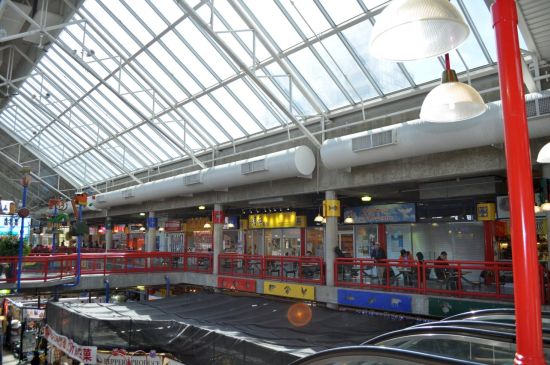We visited Richmond to see the Brighouse district, tagged by local government as an emerging urban village. We parked on the mall roof, an unvillagey place to start. After a walkabout of the area, our friend Bob Smarz decided that this is a real neighbourhood, judging from the vitality of the Asian shops and the Public Market. I am undecided.
In its 2011 census, StatsCan put Richmond’s population at 190,000, with more than 40 per cent of residents speaking a language other than English at home. Richmond city officials want to focus future population growth in the central area (see page 2-3 of the 2009 Central Area Plan), mostly in six designated urban villages. As I said in my previous post, I find the “village” vision difficult to grasp: the same six precincts would see significant growth in commercial, industrial and public-sector employment, and would also provide cultural and entertainment services on a regional scale.
A couple of the supposed villages are currently almost devoid of people, but Brighouse registered more than 8,000 residents in 2006. (It’s named for Samuel Brighouse, an early settler.) Under the Central Area Plan, the Brighouse population is supposed to triple, with development spurred by the new rapid transit link to downtown Vancouver. Most of the incomers will live in towers east of the main thoroughfare, No. 3 Road; existing detached homes and walkups will fall to the hammer. Much of the land to the west is already occupied by the mall, the Richmond General Hospital, Richmond City Hall, hockey rinks and Minoru Park. The elevated rapid transit line dominates No. 3 Road, greatly reducing (in my view) its potential as a pedestrian-friendly high street.

Land use map for Brighouse Village from the 2009 Richmond Central Area plan. The colours, from right to left, signify townhomes, dense mixed use, even more dense mixed use, and park. The diamonds mark institutional uses.
After parking the car and traversing the mall, Mr. Smarz and I stopped for lunch at Legends Pub [defunct] on Buswell Street, where the clientele was distinctly non-Asian. The bartender, whose name is Rooster, said that the property housed a federal unemployment office in the 1980s and various nightclubs in the ’90s. It is now slated to be torn down, along with the surrounding complex, and redeveloped as a mixed-use tower. The owner is seeking a new location for the pub.
 Rooster grew up not far away, on a street of detached homes near a race track. The track disappeared in favour of the Lansdowne Centre mall and two rows of apartment towers; the people of the old community have dispersed. He said that there’s nothing in central Richmond today that would qualify as a walkable concentration of shops and services.
Rooster grew up not far away, on a street of detached homes near a race track. The track disappeared in favour of the Lansdowne Centre mall and two rows of apartment towers; the people of the old community have dispersed. He said that there’s nothing in central Richmond today that would qualify as a walkable concentration of shops and services.
We proceeded to Park Road and two strip malls that are entirely taken up with Asian markets and restaurants. They were enjoying a busy Saturday, like the Brighouse Square plaza shown on the right. Bob took the view that this concentration of lively independent businesses, marks Brighouse as a true neighbourhood; I saw automobile dependency, with customers probably coming from a wide area to shop for items that may be rare in Delta or Surrey.
 If redevelopment takes place as planned, the plazas will disappear in time. The Richmond Public Market, facing on Westminster Highway, offers one model of what might replace them. It is attractive in its architectural conception, if worn at the edges, and it is well integrated with the flow of pedestrian traffic on the street. A 2011 post on the Chow Times praises the variety and low prices of the Asian food. One reader of the post called the Public Market “the closest thing in the lower mainland to a traditional Asian market.”
If redevelopment takes place as planned, the plazas will disappear in time. The Richmond Public Market, facing on Westminster Highway, offers one model of what might replace them. It is attractive in its architectural conception, if worn at the edges, and it is well integrated with the flow of pedestrian traffic on the street. A 2011 post on the Chow Times praises the variety and low prices of the Asian food. One reader of the post called the Public Market “the closest thing in the lower mainland to a traditional Asian market.”
As an outsider, I can see the advantages to living in this part of Metro Vancouver, above all for Chinese speakers. But I can’t tell you whether there is true community here, or just an odd mix of towers, retail uses and ’60s-era sprawl. The City is facilitating the growth of community associations, including a City Centre Association (although not a Brighouse Association). It may be that with time and local champions, Brighouse will build its niche and its reputation.




